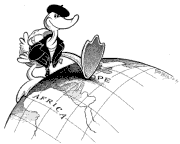03.19.07
Comparative water use in BC and US
One of the The neatest thing about living at Green College is the neat people I get to talk to all the time. One of them, Alice Cohen, gave a talk at Green recently about her research area: water. Specifically, she’s looking at the difference in water usage management between the US San Juan Islands and the Canadian Gulf Islands. These islands have the same geography and the same climate, but different legal systems depending upon which side of the US/Canadian border they fall on. This makes them an ideal study case.
With a few exceptions, drinking water in Canada falls under provincial jurisdiction. The federal guidelines only apply when drinking water is a federal responsibility (in transboundary waters, on First Nations territory, in national parks, and were it affects coastal and inland fisheries). Although some provinces have taken on the Canadian federal guidelines, most provinces use their own standards. Provinces can elect to ignore parts of the federal standard if they so choose. This makes sense sometimes. For example, Prince Edward Island basically only has groundwater, so it might not make sense to spend money testing for things that are only present in surface water.
In the US, all public drinking water supplies must conform to the federally-determined Environmental Protection Agency standards. Generally speaking, then, the Washington State official standards are higher than the British Columbia standards. (There are some exceptions. Some BC municipalities, like Vancouver and Victoria, have adopted the federal Guidelines.)
Washington and BC also have a different approach towards supply. On the US side, you have to prove that there is adequate water before you are allowed to build a house. On the Canadian side, you do not.
Alice spent last summer interviewing residents of both islands on how groundwater management worked in practice on either side of the border. She found, to her surprise, that there ended up being very little difference “on the ground” in water management from one side of the border to the other, despite very different regulations.
She found that on the Canadian side, there were more extra-legal forces that kept water use down. On one island community, for example, the residents were metered and each resident’s use was posted in a public place. This form of “peer pressure” seemed to actually work. (Note that it is many hours journey to get from the islands to “civilization”. It is thus much more important to be on good terms with your neighbors out there than in a big metropolitan area. If you need a cup of flour or a gallon of gas, you can’t just run down to the corner store.)
Meanwhile, on the US side of the border, she found that people sometimes did things without permits in order to bypass restrictions. This is one example of the way that people actually interacted with water was very similar on both sides of the border.
